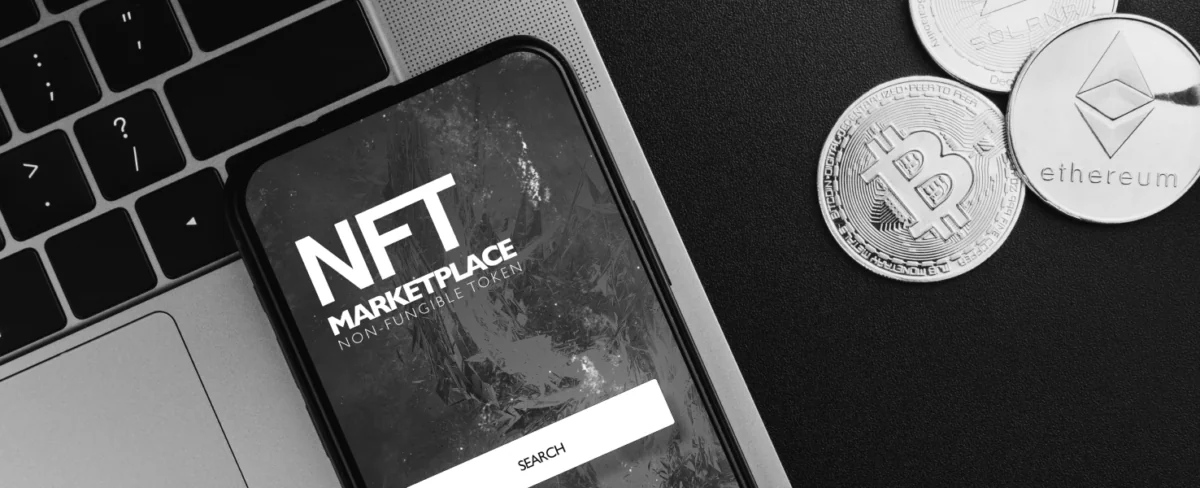In March 2021, an NFT digital collage by American artist Beeple was auctioned off by Christie's for the astounding sum of 69.3 million dollars. It was the most expensive NFT ever sold.
This event marks the notable rise of interest in NFTs. Millions of valuable NFTs get sold worldwide, and NFT marketplaces are the easiest way to trade them. Owning such a marketplace has a number of advantages. Thus, an increasing number of businesses engage in NFT marketplace development.
We gathered our practical experience as an expert agency in blockchain and crypto wallet development in this article. It contains all you need to know about NFT marketplace development. Read it through if you want to run your own NFT marketplace or use it for the creation, sale, and auctioning of your NFTs.
What Does a Non-Fungible Token (NFT) Mean?
NFT means a Non-Fungible Token representing a unique asset with settled characteristics. It cannot be exchanged for or replaced by another token of equal value.
Typical examples of NFTs include digital collectibles, virtual lands, domain names, in-game items, domain music tracks, videos, NFT art apps, essay/creative writings, unique shoes, patterns, tickets/coupons, etc. They possess the specific properties:
- NFTs are managed on a blockchain technology
- NFTs can be exchanged continuously
- NFT cannot be split into tiny denominations
Because every NFT is a unique digital asset with a unique collection of metadata, many artists and collectors digitize their work by tokenizing their commodities. Through an NFT blockchain marketplace, they trade their works in two ways: like conventional stores or auction platforms.
How Do NFT Marketplaces Work?
Here is an overview of how an NFT marketplace works and its key components:
- NFT listing. Sellers upload their NFTs onto the marketplace, sharing important information like the title, description, and asking price. They determine the sale terms, including whether it will be an auction or a fixed-price listing.
- Wallet integration. Each NFT marketplace works with various crypto wallets, so buyers can make payments, keep their NFTs, and gain ownership of the NFTs acquired. The wallet must be compatible with the marketplace.
- Buying NFTs. NFT buyers browse through the available NFTs for sale, view their ownership history, and purchase those they find interesting. Once payment in cryptocurrency goes through, the purchased NFT is moved to the buyer's digital wallet.
- Auctions and bidding. Marketplaces for NFTs can provide an option for auctions, where vendors establish a minimum price for their NFT listings, potential buyers submit offers, and the highest bidder ultimately secures the NFT. The bidding process resembles that of a traditional auction house.
- Community and discovery. NFT marketplaces may foster community interaction and help users discover new NFTs and artists. Features like social profiles, comments, and discussion forums facilitate community building and discovery on NFT platforms.
The NFT marketplace development creates an environment where NFTs can be listed for sale, discovered by potential buyers, and traded between sellers and interested buyers. They integrate cryptocurrency wallets, support transactions on the blockchain, and offer community features to help connect NFT creators and collectors.
The Reasons Why to Build Your Own NFT Marketplace
One of the renowned NFT digital art platforms, OpenSea, sold over 95 million dollars worth of NFTs in February 2021 alone. But the success of NFTs goes beyond art markets. In 2021, NFT tokens in gaming and art were worth millions of dollars. Let's consider why the NFT field is so attractive for businesses.
Like conventional marketplaces, NFT markets generate revenue by charging a transaction fee. Usually, they take 2% to 5% of each transaction. Considering the volume of transactions, you can see how successful NFT marketplaces can be. Besides profitability, NFT marketplaces have the following benefits.
Transparent Transactions
Blockchain stores encrypted information in interlinked blocks, making it traceable and unchangeable. Consequently, users trust blockchain-based solutions due to error-free payment processes and a smooth transacting experience.
Enhanced Security
All the transactions in the NFT marketplace are secured by blockchain-based smart contracts. Smart contracts are self-executing programs that run when predetermined conditions are met. They prevent funds from transaction loss and ensure no digital asset thefts or scams because all participants are sure of the outcome without any intermediary's involvement or time loss.
After payment is received, the seller transfers the ownership of those goods to a buyer. A smart contract performs as an intermediary. A smart contract will complete the transaction autonomously if all parties comply with the conditions.
Increased Liquidity of NFTs
Decentralization encourages active investment in digital assets. An NFT blockchain marketplace also has built-in liquidity capabilities that simplify exchanging or trading NFTs for other assets. You can quickly convert your NFTs into other assets without waiting for buyers.
Moreover, a rocketing increase of NFTs and cryptocurrencies draws attention from investors worldwide. It may facilitate its further rapid growth.
Lesser Financial Regulations
The critical factor in developing an NFT marketplace is building a decentralized platform. Due to blockchain technology, users can freely exchange assets there without relying on regulators, conventional financial institutions, etc. The same thing relates to marketplace regulation and certification.
Instant Payments
On the NFT marketplace, cryptocurrency transactions do not require a user's full name, address, or credit card number. It enables rapid, simple, and private payments for anyone. Hence, marketplace owners do not have any problems with payment regulation.
NFTs cannot be directly traded, unlike Bitcoins or other fungible tokens. Instead, use NFT marketplaces. Further, we describe the most popular NFT marketplaces and how they work.
NFT Marketplace Development Process
As the demand for non-fungible tokens (NFTs) continues to rise, many businesses are looking to tap into this lucrative market by creating their own NFT marketplaces. Here are the essential steps companies need to undertake:
1. Choose a Blockchain Architecture
The first stage of NFT marketplace development is selecting a suitable blockchain architecture. There are two primary options:
- creating a custom network;
- utilizing an existing one.
Creating your NFT platform structure gives you total command and the ability to customize the technological components. But, it demands substantial expertise and resources.
Leveraging existing blockchain platforms like Ethereum or Binance Smart Chain provides benefits like lower expenses, improved security, ability to scale, and access to existing frameworks and systems. However, customization and control may be limited in this case.
2. Decide Between an Open or Closed Market
Deciding between an open or closed market is the next crucial stage in the NFT marketplace development. An open marketplace allows unrestricted access to all artists and collectors, fostering a diverse and inclusive ecosystem.
A closed marketplace features exclusive access to well-known artists and creators who meet the criteria. You can adopt a hybrid strategy by integrating components from both categories, achieving a harmonious blend of transparency and quality management.
3. Define the Marketplace Features
To differentiate your NFT marketplace from competitors and attract users, define the unique features you want to incorporate. Though core functionality like user accounts, search tools, digital payment integration, and bidding systems are crucial, focus on novel capabilities. For instance, you can introduce a storefront, advanced search options, a fractional NFT concept, or gamified elements to enhance user engagement.
4. UI/UX Design
Creating an attractive and easy-to-use interface is essential for any NFT marketplace to thrive. Putting resources into high-quality UI/UX design guarantees users can move through the platform without issues, improving their satisfaction. Intuitive design elements, clear navigation, and visually appealing artwork displays contribute to creating a positive impression and encourage users to explore the marketplace.
5. Smart Contract Development
Smart contracts are the backbone of NFT marketplaces, as they facilitate the safe creation, ownership, and transfer of digital assets. Collaborating with experienced blockchain developers to create robust and secure smart contracts is vital. These smart contracts should encompass functionalities like minting, ownership verification, royalties distribution, and transaction management.
6. Integration of Payment Systems
Integrating reliable and secure payment systems is crucial to facilitating seamless transactions within your NFT marketplace. Collaborating with established payment service providers like PayPal or Apple Pay or incorporating popular cryptocurrencies like BTC and ETH as payment options ensures a smooth payment process for users while maintaining the security and transparency of transactions.
7. Testing and Launch
Before releasing an NFT trading platform, a comprehensive evaluation is critical to detect and remedy any possible flaws or weaknesses. Once all necessary tests are completed, the product can be launched, followed by a well-planned NFT marketplace marketing strategy to attract users and establish a strong market presence.
By following these 7 steps, businesses can position themselves for success in the booming NFT market.
Leveraging AI Technologies in NFT Marketplace Development
Artificial Intelligence (AI) technology is emerging as a pivotal force, revolutionizing the NFT platform development to enhance efficiency, security, and accessibility for all stakeholders. From detecting and preventing fraud to enabling AI-driven NFT minting, here are key ways in which AI is reshaping the NFT ecosystem:
AI Technologies for Fraud Detection and Prevention
One of the main challenges facing NFT marketplaces is fraud and scam activity. AI systems are leveraging transaction analysis and user monitoring to pinpoint suspicious activity. Machine learning algorithms can detect patterns that may indicate stolen artwork or wash trading designed to artificially inflate prices.
Some platforms are using AI to authenticate NFTs by comparing them against a database of original works. It helps prevent counterfeit items from being sold to unsuspecting buyers.
Enabling Accurate Price Discovery
Determining the appropriate price for an NFT is quite challenging given their subjective value. AI algorithms can analyze previous sales data, rarity metrics, and community engagement to estimate a price range for new NFT drops. These AI price prediction tools provide a more data-driven approach to valuing digital assets. AI tools are also useful in aiding buyers and sellers in making better-informed choices during trading.
Improving Recommendations
NFT marketplaces contain a massive variety of content and styles. AI recommendation engines analyze user preferences and browsing history to enable personalized suggestions. It helps connect users with relevant NFTs that align with their interests. Recommendation algorithms also allow marketplaces to promote and display NFTs that are predicted to be more popular with their target users.
Automating Content Moderation
Marketplaces must vigilantly monitor for offensive, illegal, or policy-violating content. Reviewing every NFT manually is impractical given the volumes. AI moderation tools can automatically flag inappropriate content by scanning for objectionable images, text, or metadata. It allows platforms to identify and remove problematic NFTs while maintaining a safe and compliant marketplace.
Enabling AI-Minting of NFTs
AI generative models like DALL-E 2 and Stable Diffusion can autonomously create unique NFT artwork. Developers are creating tools that allow users to mint AI-generated art directly into NFTs. While human-created NFTs will likely remain more valuable, AI minting can expand access and unlock new creative possibilities. The capabilities of AI will only continue to improve over time.
From fraud prevention to content moderation, AI is transforming how NFT platforms operate. As the technology and applications mature, AI promises to enable features of NFT marketplaces that are more efficient, secure, and inclusive for all participants. While risks like fake content generation exist, the positive potential of AI is undeniable in helping construct the future of the open metaverse.
Leading NFT Marketplaces
NFT marketplace solutions come in various shapes and sizes. They are generally divided into universal non-fungible token websites and specialized peer-to-peer marketplaces that sell specific digital assets. Each type has its pros and cons. Some non-fungible exchanges charge no fees for minting NFTs, while others only accept specific cryptocurrencies and run on various blockchains.
Let's consider some of the leading NFT marketplaces.
OpenSea
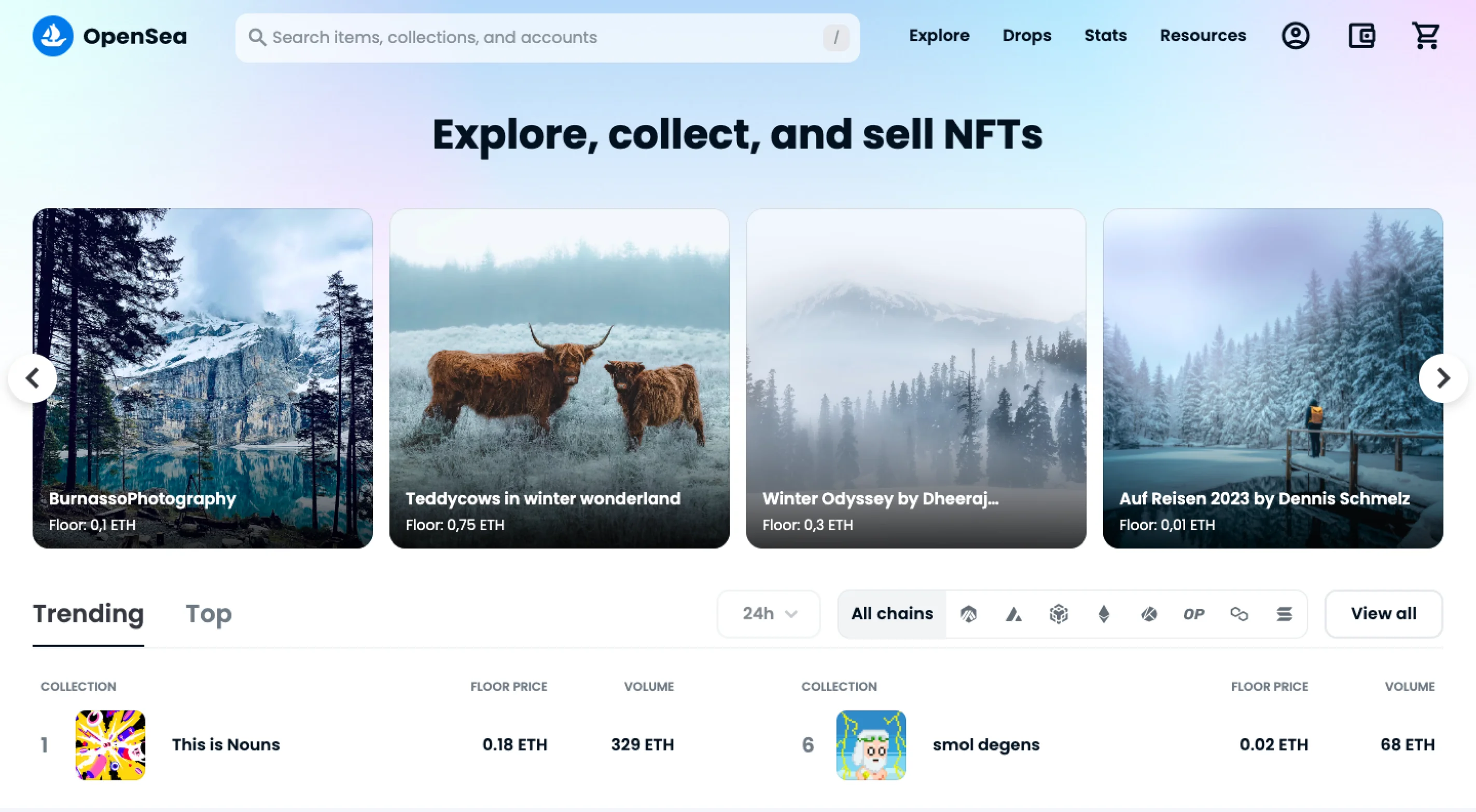
OpenSea is the number one name in the crypto NFT market. Users can find a variety of NFTs, including sports, artwork, trading cards, and more. On this NFT platform, there are a lot of unique, rare assets, such as ENS names and Decentraland. Trading card games and collectibles are also among the top categories.
Anyone can construct personal goods with the inserted minting tool. OpenSea is excellent for working on a blockchain smart contract for an app or collecting original goods on a blockchain.
Atomic Hub
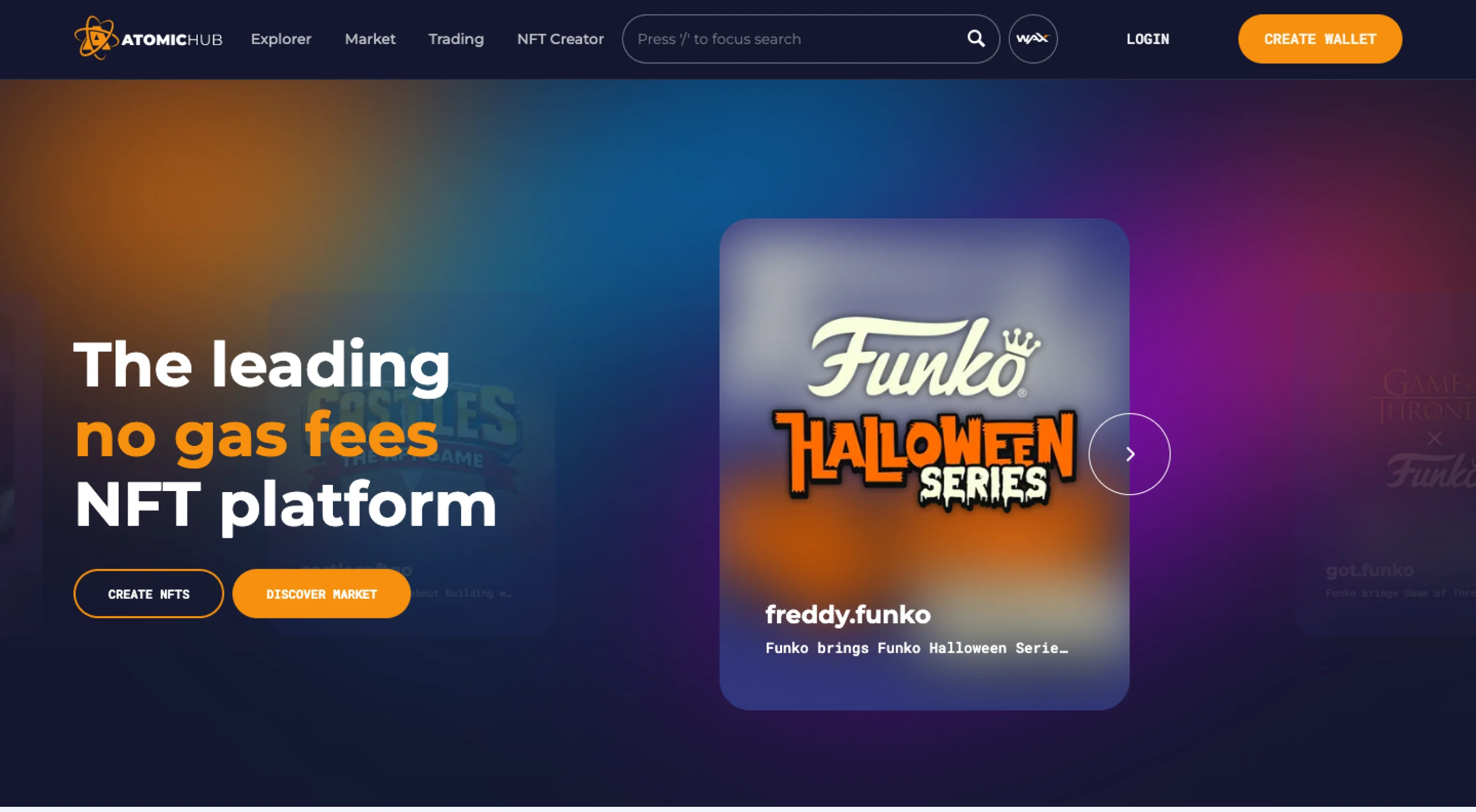
Atomic Hub is also a great choice for an NFT marketplace for digital art, holding top ranks on the Wax blockchain. There, users can exchange goods for native Wax money. On this website, making an NFT collection is quite simple. Users can create their goods entirely from scratch or base their collectibles on a common theme.
SuperRare
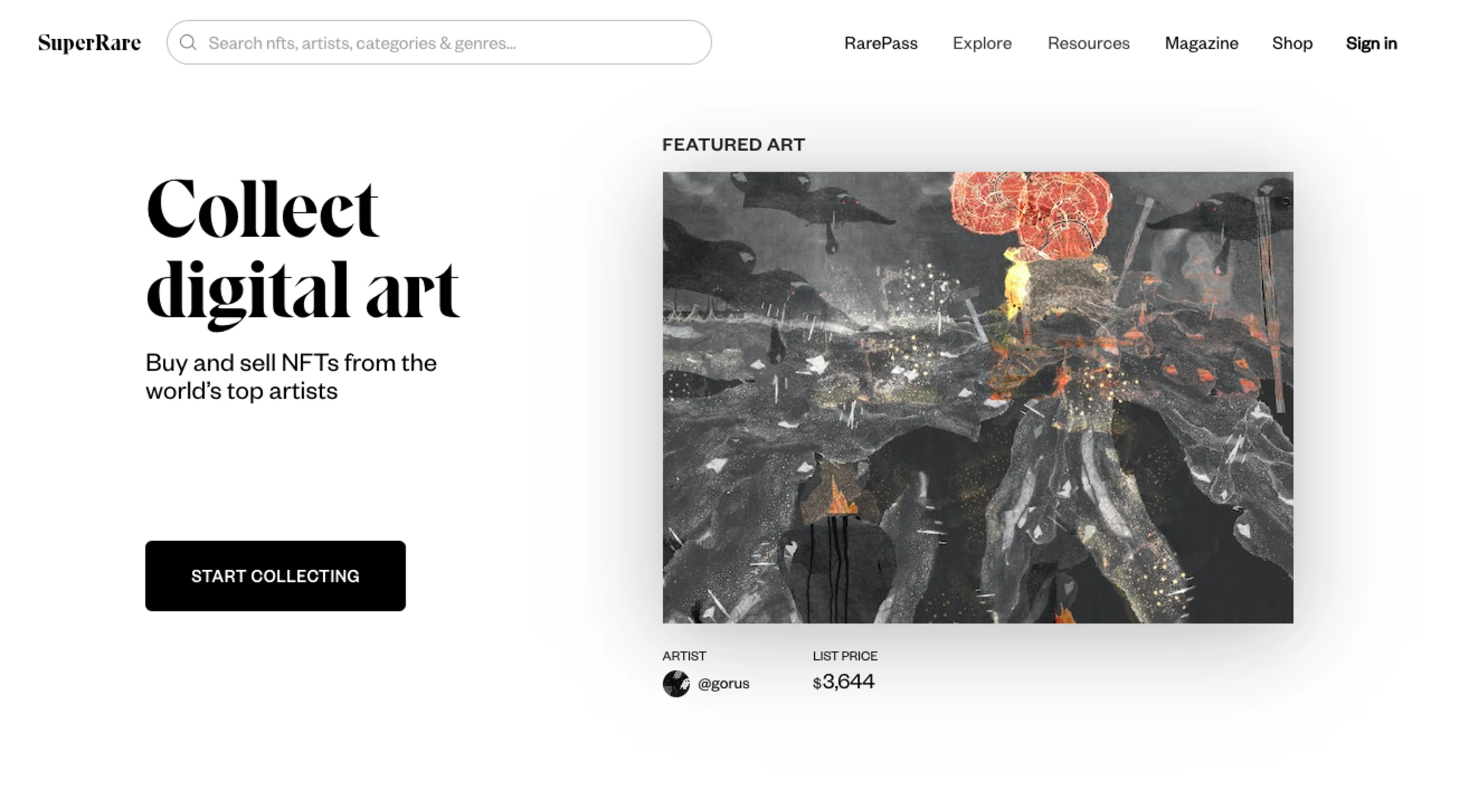
This platform allows the publishing and selling of works only by proven authors who have produced significant works of art. Getting through the registration and verification processes could take time and effort. Additionally, you'll need Ethereum to participate in exchanges on SuperRare.
Rarible
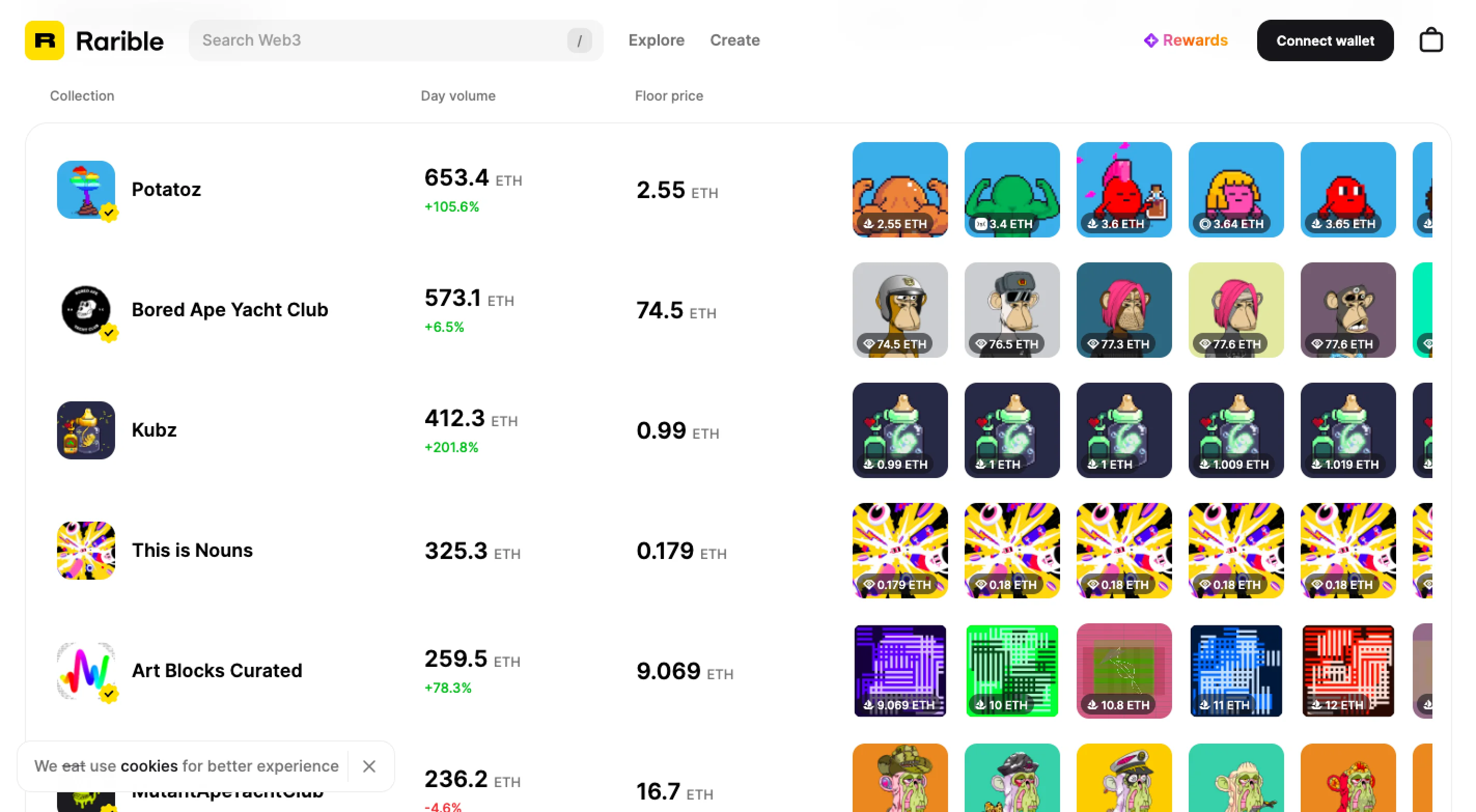
Rarible is another Ethereum-based NFT marketplace. It makes it easier to create, sell, and buy ownership rights to digital works of art. This service belongs to the blockchain community and rewards top customers, sellers, and active players with a native coin called $RARI. This NFT digital art platform allows exceptional artists to share their songs, albums, movies, domains, pictures, cards, and metaverse elements.
If building NFT marketplace is in your plans, read the following section about the essential features of NFT marketplaces.
Must-Have Features of NFT Marketplace
NFT digital art platforms, in general, resemble conventional e-commerce marketplaces, except they are run on blockchain technology. We gathered the primary features to implement in your future marketplace.
Storefront
It is the most critical task. This selection ought to include data on, among other things, previews, bids, owners, and price histories.
Advanced Token Search
Consumers must quickly and easily obtain the most accurate information about their required products. Everything should be sorted using various criteria (it can be, for example, memes, images, videos, art, music, and many more). Customer satisfaction is increased through quick and simple searches.
Filters
Filters help to sort by prices, bestsellers, mark hot bargains, new items, recently listed, etc. The complete list of filters is endless. Due to it, customers spend less time choosing proper goods in the NFT digital art platforms. To sort all offers into various groups, you need a separate function.
Creating Listings
Give your clients the option to send and produce collectibles if necessary. Help them complete it quickly and without any obstacles. Make a page where customers can upload files and enter the essential information. Title, description, and tag information are all required.
Listing Status
If you need collectible verification in your NFT marketplace, this option is helpful. Those who supply things and should pass the verification process will benefit from this functionality. They can monitor the confirmation status thanks to it.
Bidding Option
Bidding attracts more customers, as the process is always enjoyable. Specify a bid deadline and display the status of the offers right now. It helps bidders determine if it is better to buy a digital item right now or to continue bidding. Another type of auction is when a seller offers at a minimum price and awaits bids. After a certain period, they accept the highest bid, like on eBay.
Wallet
Customers must have access to a safe and secure online location to receive and store NFTs. For the users to keep and submit their tokens securely, an NFT blockchain marketplace uses a wallet.
You can design and provide a connected, "native" wallet, eliminating users' requirement to sign up using other online wallets. Make sure that your convenience comes first. If you need assistance, S-PRO crypto wallet developers are ready to help. We handle the process from the discovery stage to maintenance, so the clients are freed from the development routines and can concentrate on their business strategy.
Ratings
Beginners might need help knowing where to start or how the blockchain system works. To ensure their quick onboarding and further purchases, use ratings. Ratings enable the parties to assess each other's credibility in this manner. The top-ranked users receive attractive incentives.
Since you know which features to include in your project scope, it's time to choose a vendor. We prepared a detailed comparison of NFT marketplace development options to ease your choice.
Using Ready-made NFT Marketplace Tools VS Custom NFT Marketplace Development
If you want to create own NFT marketplace, you have two options. You may refer to ready-to-use services like OpenSea SDK or create from scratch a custom NFT marketplace. The latter will take more time and money to launch, but it will be unique.
We compared these two approaches for your convenience to pick one.
| Ready-made Tools | Custom Development | |
|---|---|---|
| Security | The prepared tool is a third party with access to all data stored on the server. Thus, it makes an additional threat. | Such services are well-protected, thanks to a customizable range of security tools. Besides, you do not deal with third parties, so you control the NFT data. |
| Compatibility | There is a possibility of errors while launching on various devices. | The NFT marketplace will be optimized to work with various devices, from PCs to smartphones. |
| Scalability | As a project grows, it may require individual solutions depending on how it shapes. | It can accommodate several listings and a rising clientele as the business grow. |
| Functionality | You have a limited choice of predefined features. | Based on marketing analysis, you develop an architecture and features. Anything can be put into practice. |
| Price | Ready-made templates save time and, therefore, money for development. | Creating anything from scratch requires you to invest even more time and money. |
| Management | Build-in solutions help to concentrate only on the marketing and content. | You need a dedicated NFT development team to maintain the solution. Additionally, managing workers and finding qualified applications may be complex. |
| Time | Ready-to-use templates help to reduce the delivery period. | If you want a totally personalized and individualized business, prepare to invest time and effort. |
In the end, custom crypto NFT marketplace development resembles a tailored suit that is perfect to match the best features but requires a considerable amount of time and money. If you search for a simple and quick solution, refer to a market of ready-made clothes.
If you plan to build your own NFT marketplace solution, S-PRO is ready to help. We are experts in cryptocurrency exchange platform development. Also, our company builds all-inclusive NFT platforms where users can trade arts, collectibles, and other valuables using non-fungible tokens.
How Much Does It Cost to Build a Crypto NFT Marketplace?
Many factors influence the price of such a project. To start with, the platform for your NFT project has an impact on the cost. For example, it might be an OpenSea SDK or a unique Ethereum NFT marketplace solution.
The increased complexity pushes the price up. The development process may cover UX/UI design, security, user profiles, pages (main, products, ratings, etc.), notifications, crypto integration, Buyer/Seller/Admin panels, and so on.
Your project may take more than 1,000 hours to finish. A development price varies from $50,000 to $500,000. Partly, Western European and American development teams charge the highest fees. Eastern European specialists set lower costs while maintaining compelling quality.
S-PRO unites more than 250 specialists from many countries, including Poland, Ukraine, Switzerland, Romania, and Germany. We can assist if you opt to use ready-to-use devkits or plan to build a platform from scratch. Refer to our top-notch specialists for a consultation.
Summary
NFTs are a cutting-edge technology that gains coming popularity. As NFT market transactions happen on the blockchain, they are of top security. Transparent and instant payments add trust to the platform, while lesser financial regulations leave space for flexible trading of digital goods.
If you plan to build your own NFT marketplace, opt between ready-made tools and custom developers. The first is quicker to implement but harder to maintain. In contrast, the latter requires a larger budget and time but results in unique and scalable solutions.
Consult S-PRO; addressing our services can be a good aid for your future commercial success. Contact us to book a free consultation with one of our specialists.
FAQ
What is an NFT platform?
A digital marketplace for purchasing and selling NFTs is known as an NFT marketplace. These platforms enable users to store, show, and sell their NFTs to other users in exchange for cryptocurrencies or cash.
NFTs can be sold at fixed prices or through bids in auctions. You need to have a crypto wallet connected to the platform to buy one.
How Do NFT Marketplaces Work?
NFT management happens on a blockchain. One of the most used blockchains for NFTs is Ethereum. However, the choice is not limited to it.
These blockchains serve as a distributed ledger to track each NFT's ownership and transaction history. Additionally, the NFT's code and ID ensure that no other token can imitate it.
Thus, transactions are transparent and secure.
How to build an NFT marketplace?
The main thing about creating NFT marketplaces is that you need to understand the roles of the project participants. After that, create a roadmap for your project.
Then it is time to choose a contractor to write the code, create a design, and deploy the project. If you require help with that, we are here for it.

